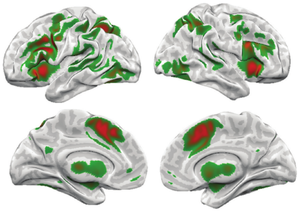Body-budgeting details
Chapter 4 endnote 54, from How Emotions are Made: The Secret Life of the Brain by Lisa Feldman Barrett.
Some context is:
[Neurologist Helen] Mayberg’s remarkable work might represent the first time in scientific history that direct stimulation of the human brain has consistently changed people’s affective feelings, potentially leading to new treatments for mental illness. [...] The neurons stimulated by Mayberg are not specific for affect, however.
During depression, the subgenual anterior cingulate cortex (sACC) is hyperactive, potentially because of poor management of the body budget. Long-term brain stimulation (for intractable depression) decreases sACC activity to more normal levels.[1][2] Mayberg is basically tuning budget predictions that the sACC sends to the body, as well as the interoceptive predictions that drive interoceptive sensations and affect.[3][4] I should also point out that a hyperactive sACC is not specific to intractable depression — we also see it in anxiety.
Even with all this evidence, I’m still not sure we can claim that the body-budgeting limbic regions “compute” affect. Why? Because their neurons are not specific for affect. They continuously send body-budgeting predictions, as well as sensory predictions, and they are clearly important to affect, since the neurons in these areas increase in activity as people report strong changes in affective feelings. But these regions are not exclusively designed for affect.
Here are just a couple of examples to make my point.
- When you’re hungry, do you choose an apple or an orange? Or in my case, apple or potato chips? In some studies, neurons stretching from the sACC to the neighboring vmPFC predict this kind of choice (which scientists call “value”) but not whether one food is liked more than another (which is affect).[5]
- My lab has measured increased activation in these body-budgeting regions that had nothing to do with affect. In one brain imaging study, we showed a variety of objects to test subjects. Some objects were common and easily associated with other objects, such as a ball, while others were less common and harder to associate with other objects, such as binoculars. The more common objects were associated with more of an activity increase in these brain regions, independent of the object’s value or affective significance.[6] As for why, I can only speculate that this task required the brain to launch many more simulations for a common object, since it has so many uses (you can bounce a ball, catch a ball, throw a ball, etc.), which translated into more interoceptive predictions.

Two other body-budgeting regions (the anterior insula and the anterior mid cingulate cortex) are “hot spots” that coordinate activity across several intrinsic brain networks. They show a consistent increase in activity in almost 6,000 brain imaging experiments spanning dozens of different psychological domains, many of which had nothing explicitly to do with affect.[7]
Notes on the Notes
- ↑ Mayberg, Helen S., Andres M. Lozano, Valerie Voon, Heather E. McNeely, David Seminowicz, Clement Hamani, Jason M. Schwalb, and Sidney H. Kennedy. 2005. "Deep brain stimulation for treatment-resistant depression." Neuron 45 (5): 651-660.
- ↑ Kennedy, Sidney H., Peter Giacobbe, Sakina J. Rizvi, Franca M. Placenza, Yasunori Nishikawa, Helen S. Mayberg, and Andres M. Lozano. 2011. "Deep brain stimulation for treatment-resistant depression: follow-up after 3 to 6 years." American Journal of Psychiatry 168: 502-510.
- ↑ Goldapple, Kimberly, Zindel Segal, Carol Garson, Mark Lau, Peter Bieling, Sidney Kennedy, and Helen Mayberg. 2004. "Modulation of cortical-limbic pathways in major depression: treatment-specific effects of cognitive behavior therapy." Archives of General Psychiatry 61 (1): 34-41.
- ↑ Aupperle, Robin L., Carolyn B. Allard, Alan N. Simmons, Taru Flagan, Steven R. Thorp, Sonya B. Norman, Martin P. Paulus, and Murray B. Stein. 2013. "Neural responses during emotional processing before and after cognitive trauma therapy for battered women." Psychiatry Research: Neuroimaging 214 (1): 48-55.
- ↑ Clithero, John A., and Antonio Rangel. 2013. "Informatic parcellation of the network involved in the computation of subjective value." Social Cognitive and Affective Neuroscience 9 (9): 1289-1302.
- ↑ Shenhav, Amitai, Matthew M. Botvinick, and Jonathan D. Cohen. 2013. "The expected value of control: an integrative theory of anterior cingulate cortex function." Neuron 79 (2): 217-240.
- ↑ Clark-Polner, Elizabeth, Wager, Tor D., Satpute, Ajay B., & Barrett, Lisa Feldman. 2016. "Neural Fingerprinting: Meta-Analysis, Variation, and the Search for Brain-Based Essences in the Science of Emotion." In Handbook of Emotions, 4th edition, edited by Lisa Feldman Barrett, Michael Lewis, and Jeannette M. Haviland-Jones, 146-165. New York: Guilford Press.